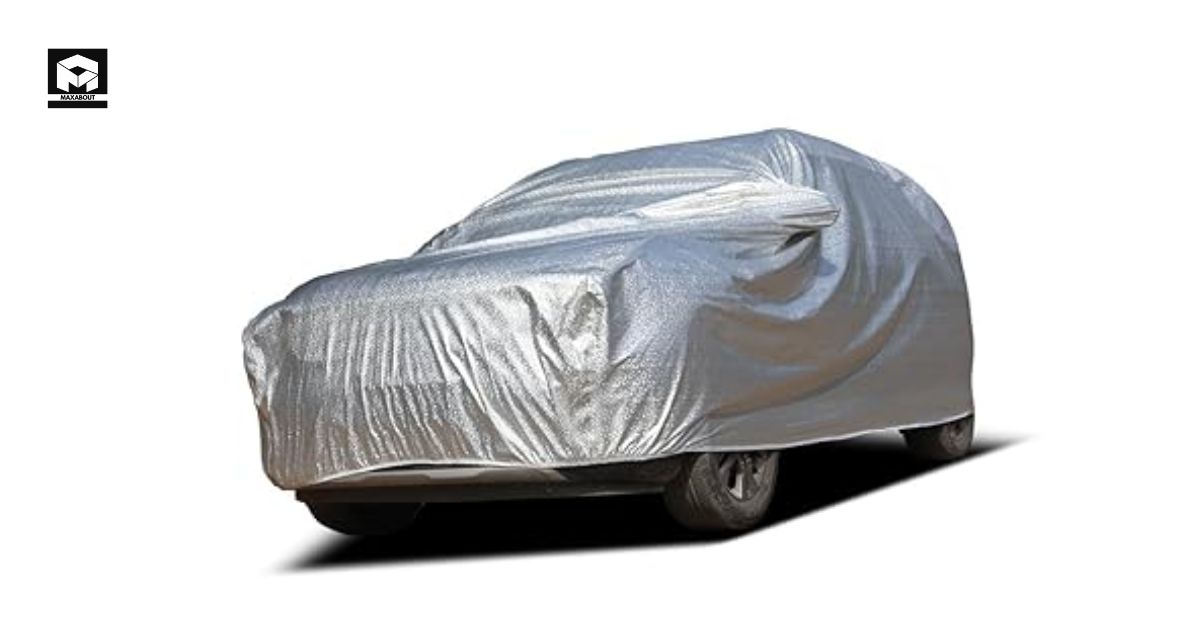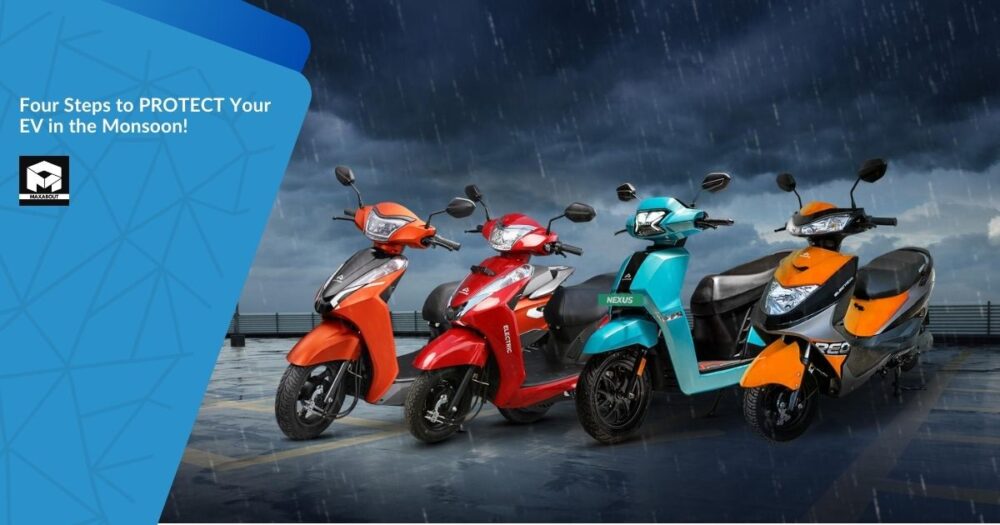As the monsoon season approaches, electric vehicle (EV) owners need to be extra careful to protect their rides from rain and water damage. With a few simple steps, you can ensure that your electric bike or scooter remains in great condition, even during heavy downpours. Here are four essential steps to safeguard your EV this rainy season.
Key Takeaways
- Always park your EV in a covered area to avoid rain damage.
- Use a waterproof cover to protect against moisture and rust.
- Check the battery regularly for signs of water damage and maintain its health.
- Inspect and repair seals around doors and charging ports to keep water out.
- Avoid charging your EV during thunderstorms to prevent electrical issues.
Choose a Covered Parking Spot

Benefits of Covered Parking
Choosing a covered parking spot for your electric vehicle (EV) can greatly protect it from the harsh elements. Keeping your EV sheltered from rain and wind helps prevent water damage and rust. Here are some key benefits:
- Protection from Rain: Reduces the risk of water entering sensitive areas.
- Temperature Control: Keeps your vehicle cooler in hot weather.
- Less Cleaning: Reduces dirt and debris accumulation.
Types of Covered Parking Options
There are several options for covered parking that you can consider:
- Garages: Ideal for complete protection.
- Carports: Offer good shelter while being more open.
- Designated Parking Areas: Some places have specific spots with roofs.
How to Set Up a Covered Parking Spot
Setting up a covered parking spot is easier than you think. Here’s how:
- Find a Suitable Location: Look for a garage or carport nearby.
- Consider Temporary Solutions: If you don’t have a permanent spot, think about using a pop-up canopy.
- Check Local Regulations: Ensure that your chosen spot complies with any local rules.
Remember, a little planning can go a long way in keeping your EV safe during the monsoon season!
Use a Waterproof Cover

Advantages of Waterproof Covers
Using a waterproof cover for your electric vehicle (EV) can significantly enhance its protection during the monsoon season. This cover acts as a barrier against rain, dirt, and other elements. Here are some key benefits:
- Prevents water from reaching sensitive parts like sensors and terminals.
- Reduces the risk of rust forming on metal components.
- Keeps your EV cleaner, minimizing the need for frequent washes.
Choosing the Right Cover
When selecting a waterproof cover, consider the following:
- Material: Look for high-quality, durable materials that are specifically designed to be waterproof.
- Fit: Ensure the cover fits your EV snugly to prevent it from blowing away in strong winds.
- Breathability: Choose a cover that allows moisture to escape, preventing mold and mildew.
Properly Securing the Cover
To maximize the effectiveness of your waterproof cover, follow these steps:
- Lay the cover flat on the ground before placing it over your EV.
- Secure the cover with straps or ties to keep it in place during windy conditions.
- Check regularly to ensure the cover remains intact and adjust as needed.
Keeping your EV protected with a waterproof cover is a simple yet effective way to extend its lifespan and maintain its performance during the rainy season.
Regularly Inspect the Battery
Checking for Water Damage
It’s essential to keep an eye on your EV’s battery. Water can seriously harm its performance. Regularly check the battery compartment for any signs of moisture or corrosion. Here are some steps to follow:
- Look for any visible water or dampness.
- Check for rust or corrosion on battery terminals.
- Ensure the battery casing is intact and free from cracks.
Maintaining Battery Health
To keep your battery in top shape, you should:
- Monitor the battery’s charge levels regularly.
- Inspect insulation and connectors for any damage.
- Be aware of any unusual smells or sounds coming from the battery.
Signs of Battery Issues
Watch for these warning signs that your battery may need attention:
- Decreased range or performance.
- Warning lights on the dashboard.
- Difficulty in charging or maintaining charge.
Regular inspections can help you catch problems early, ensuring your EV runs smoothly and lasts longer.
Check and Maintain Seals
Importance of Seals
Seals are essential for keeping water out of your electric vehicle (EV). They help protect sensitive areas like doors, windows, and the charging port. Regular checks can prevent water damage and keep your EV running smoothly.
How to Inspect Seals
- Look for Cracks: Check all seals around doors and windows for any visible cracks or gaps.
- Feel for Air Leaks: Close the doors and windows, then feel around the edges for any drafts.
- Check the Charging Port: Ensure the seal around the charging port is intact and not worn out.
Repairing Damaged Seals
- Replace Worn Seals: If you find any damaged seals, replace them as soon as possible.
- Use Sealant: For minor gaps, a waterproof sealant can be applied to prevent water from entering.
- Consult a Professional: If you’re unsure about the condition of your seals, it’s best to consult a technician.
Keeping your seals in good condition is crucial for protecting your EV from the elements. Regular maintenance can save you from costly repairs later.
Keep the Charging Area Dry
Why a Dry Charging Area is Crucial
Keeping your charging area dry is essential for the safety and performance of your electric vehicle (EV). Moisture can lead to electrical issues and damage the battery. A dry environment helps ensure that your EV charges efficiently and safely.
Tips for Keeping the Area Dry
- Choose a sheltered location: Whenever possible, park your EV in a garage or under a carport to protect it from rain.
- Use a waterproof cover: If you must park outside, consider using a waterproof cover for your EV to keep it dry.
- Regularly check for leaks: Inspect the area around your charging station for any signs of water pooling or leaks.
Keeping your charging area dry not only protects your EV but also extends the life of its battery. Regular maintenance and checks can prevent costly repairs.
What to Do If the Area Gets Wet
- Dry the charging port: If the charging area gets wet, make sure to dry the charging port before plugging in.
- Avoid charging immediately: If there’s significant water, wait until everything is dry before charging your EV.
- Inspect for damage: After a wet incident, check for any signs of damage to the charging equipment or the vehicle.
Monitor Tire Conditions
Checking Tire Pressure
Regularly checking your tire pressure is essential for safe driving. Properly inflated tires provide better traction and control. Here’s how to do it:
- Use a tire pressure gauge to check the pressure.
- Compare the reading with the recommended pressure found in your vehicle’s manual.
- Inflate or deflate as needed to maintain the correct pressure.
Inspecting for Wear and Tear
Keeping an eye on your tires for any signs of damage is crucial. Look for:
- Cracks or cuts on the tire surface.
- Bulges or blisters that may indicate internal damage.
- Tread depth; use a penny to check if the tread is still adequate.
Replacing Damaged Tires
If you find any issues during your inspection, it’s important to act quickly. Here’s what to do:
- If a tire is flat or severely damaged, replace it immediately.
- Consider replacing tires in pairs for balanced handling.
- Always consult a professional if you’re unsure about the condition of your tires.
Keeping your tires in good shape is vital for your safety, especially during the rainy season. Regular checks can help prevent accidents and ensure a smooth ride.
Protect Electrical Components
Shielding the Cluster Area
To keep your EV safe during the monsoon, it’s important to protect the cluster area, which includes the instrument panel. Using a cover can help prevent water damage. Here are some tips:
- Use a transparent cover to shield the area from rain.
- Ensure the cover fits snugly to avoid water seeping in.
- Regularly check the cover for any wear and tear.
Inspecting Electrical Connections
Regular checks on electrical connections can save you from future problems. Here’s what to do:
- Look for any signs of corrosion or rust on connectors.
- Ensure all connections are tight and secure.
- If you notice any damage, get it fixed right away.
Using Protective Gear
Using protective gear can help keep your EV’s electrical components safe. Consider these options:
- Waterproof covers for sensitive areas.
- Insulated charging cables to prevent moisture damage.
- Weatherproof storage for your EV when not in use.
Keeping your EV’s electrical components dry is crucial for its performance and longevity. Regular maintenance and protective measures can help you avoid costly repairs.
Avoid Riding Through Deep Water
Risks of Deep Water
Driving through deep water can be dangerous for your electric vehicle (EV). Even though EVs are designed to be water-resistant, deep water can still cause serious damage. Here are some risks to consider:
- Water can enter sensitive areas, leading to electrical issues.
- Hidden obstacles in the water can damage your vehicle.
- You may lose control, increasing the chance of accidents.
Alternatives to Deep Water Routes
Instead of risking your EV, look for safer options:
- Choose alternate routes that are dry and safe.
- Wait for the water to recede before continuing your journey.
- Use public transport if the weather is too severe.
What to Do If You Encounter Deep Water
If you find yourself facing deep water, follow these steps:
- Assess the depth before attempting to cross.
- If it looks too deep, turn around and find another way.
- If you must go through, drive slowly and steadily to maintain control.
Remember, keeping your EV safe is more important than getting to your destination quickly. Avoiding deep water can save you from costly repairs and ensure a smoother ride.
Schedule Professional Check-Ups
Benefits of Professional Maintenance
Scheduling regular check-ups for your EV is essential. It helps keep your vehicle in top shape. Here are some key benefits:
- Expert Inspection: Trained technicians can spot issues you might miss.
- Preventive Care: Regular maintenance can prevent bigger problems down the road.
- Safety Assurance: Ensures your EV is safe to drive, especially in bad weather.
When to Schedule Check-Ups
It’s wise to plan check-ups at specific times:
- Before the Monsoon: Get your EV ready for the rainy season.
- After Heavy Rains: Check for any water damage or issues.
- Regular Intervals: Aim for at least twice a year for routine maintenance.
What to Expect During a Check-Up
During a professional check-up, you can expect:
- Thorough Inspection: Technicians will check the battery, seals, and electrical components.
- Maintenance Services: They may perform necessary repairs or replacements.
- Advice on Care: You’ll receive tips on how to keep your EV in great condition.
Regular check-ups are not just about fixing problems; they are about ensuring your EV runs smoothly and safely, especially during challenging weather conditions.
Use Mud Flaps
Advantages of Mud Flaps
Mud flaps are a great addition to your electric vehicle (EV) during the monsoon. They help to:
- Prevent mud and water splashes from hitting your vehicle.
- Keep your EV cleaner, reducing the need for frequent washes.
- Protect against rust and corrosion by minimizing exposure to debris.
Installing Mud Flaps
To install mud flaps on your EV, follow these steps:
- Choose the right size for your vehicle.
- Securely attach them to the wheel wells using screws or clips.
- Ensure they are positioned correctly to cover the tires effectively.
Maintaining Mud Flaps
To keep your mud flaps in good shape:
- Regularly check for wear and tear.
- Clean them to remove mud and dirt buildup.
- Replace them if they become damaged or worn out.
Adding mud flaps is a simple yet effective way to protect your EV from the harsh conditions of the monsoon. They not only enhance the vehicle’s appearance but also extend its lifespan.
Avoid Charging During Thunderstorms
Risks of Charging During Storms
Charging your electric vehicle (EV) during thunderstorms can be risky. Lightning strikes and power surges can damage your battery and electrical systems. Here are some reasons to avoid charging:
- Electrical surges can cause short circuits.
- Water exposure can lead to corrosion and battery damage.
- Charging in wet conditions increases the risk of electrical shock.
Safe Charging Practices
To keep your EV safe during storms, follow these tips:
- Charge indoors if possible, away from rain and wind.
- Ensure the charging area is dry before plugging in.
- Use a surge protector to guard against power spikes.
What to Do If You Need to Charge
If you must charge during a storm, take precautions:
- Check that the charging port is dry before connecting.
- Monitor the charger for any signs of malfunction.
- If lightning is nearby, unplug immediately and wait for the storm to pass.
Remember, safety first! Avoiding charging during thunderstorms can help protect your EV from potential damage.
Regularly Clean Your EV
Keeping your electric vehicle (EV) clean is essential, especially during the monsoon season. Regular cleaning helps prevent damage and keeps your EV looking great. Here are some key points to consider:
Best Cleaning Practices
- Use a soft cloth to wipe down the exterior to avoid scratches.
- Rinse off mud and dirt as soon as possible to prevent buildup.
- Clean the wheels and undercarriage to remove any debris that can cause rust.
Areas to Focus On
- Battery compartment: Ensure it’s free from moisture and dirt.
- Charging port: Keep it clean and dry to avoid charging issues.
- Sensors and cameras: Wipe them gently to maintain visibility and functionality.
Drying Your EV Properly
- After washing, use a microfiber towel to dry your EV thoroughly.
- Make sure to dry the charging port and any seals to prevent water damage.
Regular cleaning not only enhances the appearance of your EV but also extends its lifespan. Make it a habit to check and clean your vehicle, especially after heavy rains.
Final Thoughts
In conclusion, taking care of your electric vehicle during the monsoon is essential for keeping it in great shape. By parking it in a dry spot, using a waterproof cover, checking for pests, and cleaning it gently, you can help prevent damage. Remember, a little effort goes a long way in ensuring your EV stays safe and reliable through the rainy season. So, gear up and enjoy your rides, rain or shine!
Frequently Asked Questions
How can I protect my EV from rain damage?
You can protect your EV by parking it in a covered area, using a waterproof cover, and regularly checking the battery and seals.
What should I do if my EV gets wet?
If your EV gets wet, dry it off as soon as possible, especially the battery and electrical parts, to prevent damage.
Is it safe to charge my EV during a thunderstorm?
No, it’s best to avoid charging your EV during thunderstorms to prevent electrical issues.
How often should I check my EV’s battery?
You should inspect your EV’s battery regularly, especially before and after the rainy season.
What are the signs of battery issues in an EV?
Signs of battery problems include reduced range, warning lights on the dashboard, or unusual noises.
Why are seals important for my EV?
Seals help keep water out of important areas, protecting the electrical components and battery.
How can I keep my charging area dry?
To keep your charging area dry, use a cover or park in a sheltered spot, and check for any water accumulation.
What should I do if I encounter deep water while riding?
If you encounter deep water, it’s best to turn around or find an alternate route to avoid potential damage.

